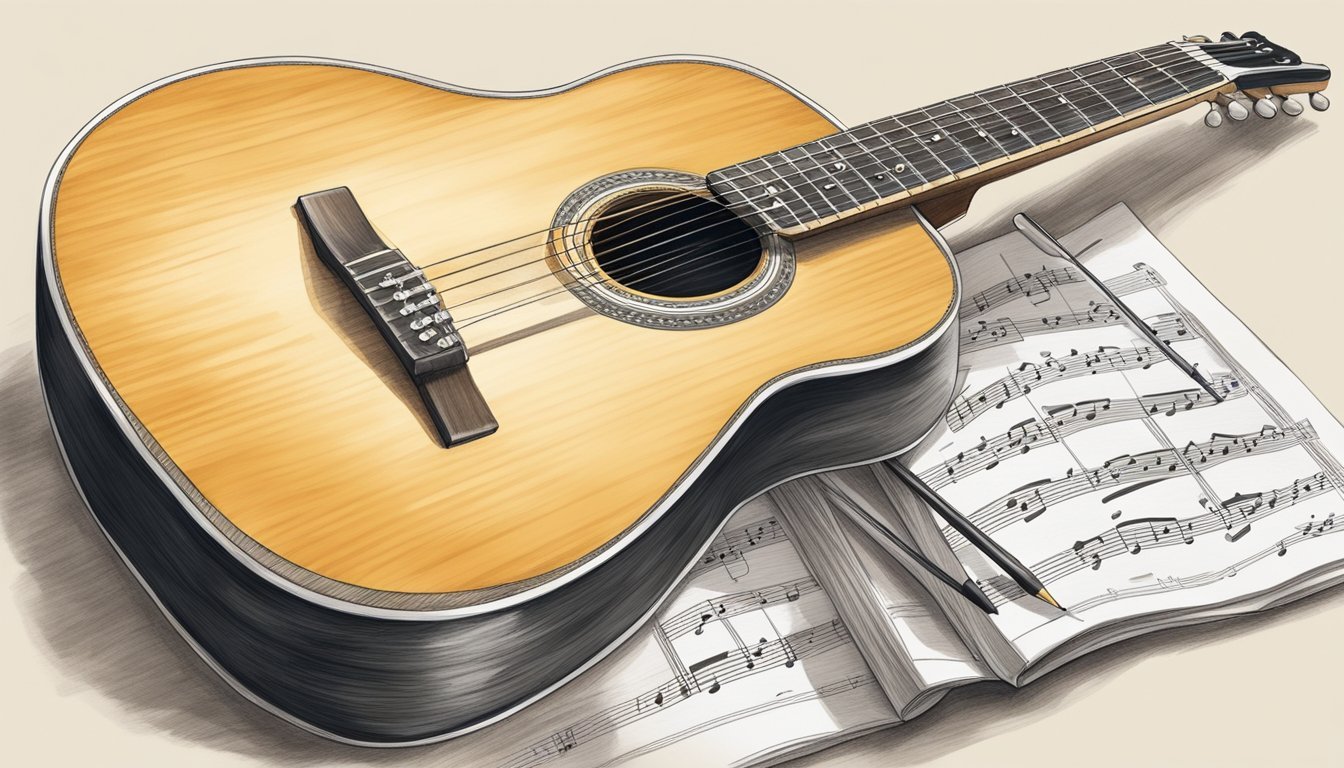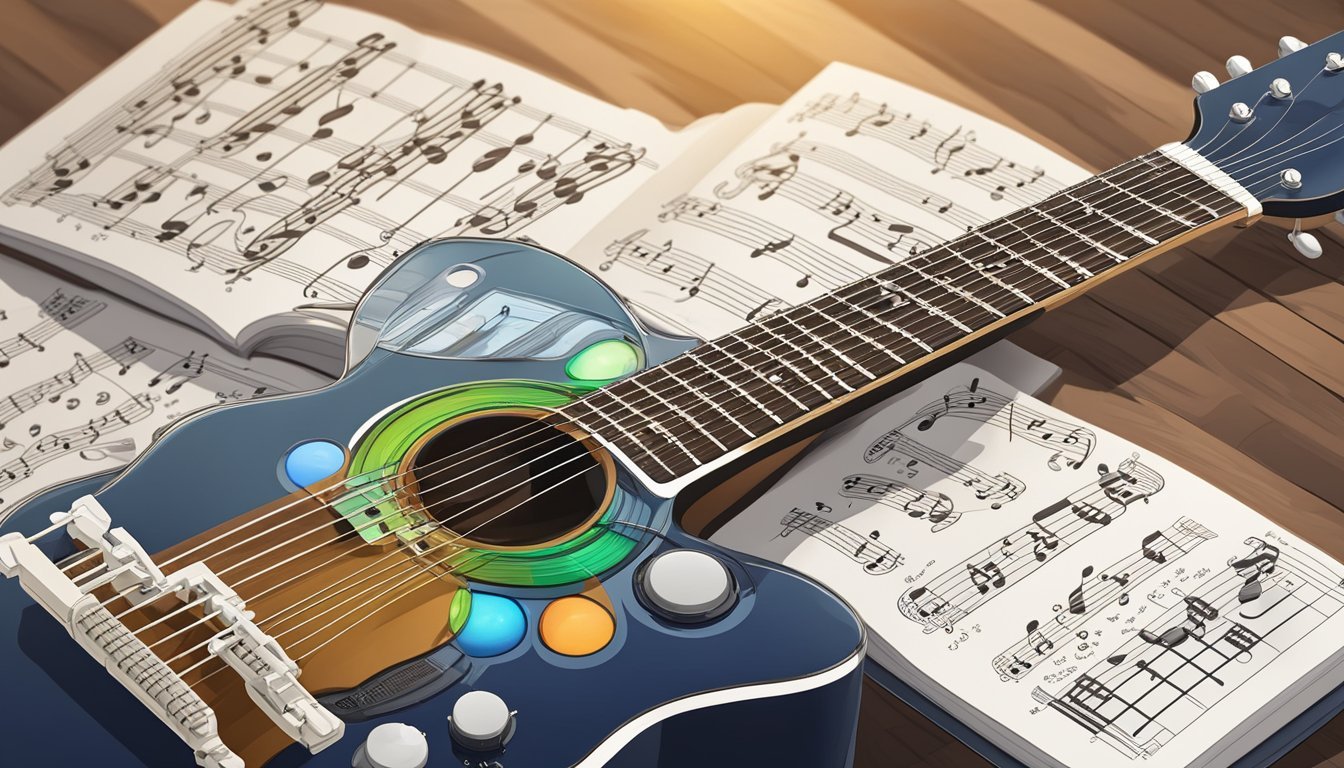Learning to read guitar notes is a crucial skill for any guitarist.
Understanding the basics of guitar notation can enhance your playing and open up new musical opportunities.
Whether you’re a beginner or someone looking to brush up on your skills, knowing how to interpret guitar music can make a significant difference.

As you dive into the world of guitar notes, you’ll encounter different forms of music notation, such as standard sheet music and tabs.
Each method has its own unique features and advantages, allowing you to express your musical ideas more clearly.
Grasping these concepts will empower you to play your favorite songs with confidence and creativity.
With the right approach, reading guitar notes can be fun and rewarding.
It’s all about practice and understanding the fundamentals so you can play your favorite tunes and even create your own.
Key Takeaways
- Understanding basic music theory helps in reading guitar notes.
- Familiarity with tabs and sheet music is essential for guitarists.
- Practice is key to improving your music reading skills.
The Basics of Guitar Notes and Music Theory
To play guitar well, you need to understand some basic concepts about notes and how they work in music theory.
This section covers the structure of the guitar fretboard, how to identify notes and pitch, and an introduction to reading music notation.
Understanding the Guitar Fretboard
The guitar fretboard is where the magic happens.
It has frets, which are the metal strips, and open strings, which produce notes without pressing down any frets.
In standard tuning, the strings are tuned to E, A, D, G, B, and E from the lowest to the highest string.
Here’s a quick breakdown:
- E: 0 fret (open string) = E note
- F: 1 fret = F note
- F#: 2 fret = F# note
- And so on.
As you move along the fretboard, each fret represents a half step in pitch.
Knowing this helps you find natural notes and their sharps and flats easily.
Decoding Notes and Pitch
Notes are the building blocks of music.
Each note corresponds to a specific pitch.
When you play a note on the guitar, you’re using the fretboard to find that pitch.
There are natural notes (A, B, C, D, E, F, G) and their sharps (♯) and flats (♭).
For example, the note C can also be played as B♯ or D♭, depending on the context.
Understanding this helps you navigate through scales and chords.
To remember where notes are, you can use mnemonics or fretboard charts.
Knowing the order of notes helps you play more confidently.
Intro to Music Notation: Staff, Clefs, and Notes
Music notation uses a staff to represent notes.
The staff consists of five lines and four spaces, where each line and space corresponds to a specific note.
For guitar, we often use the treble clef, which is the symbol at the beginning of the staff.
The notes on the staff represent pitches that you can play on your guitar.
Here are some common notes:
- E (1st line)
- G (2nd line)
- B (3rd line)
When you see sharps or flats in your music, they change these notes slightly in pitch.
Learning to read the staff will help you play songs and understand music theory better.
Reading Guitar Music: Tabs and Sheet Music
When learning to read guitar music, you’ll encounter two main types: guitar tabs and sheet music.
Each has its own style and system, so it’s helpful to understand both to improve your playing.
Guitar tabs are a simplified way to represent music, using numbers and lines to indicate where to place your fingers on the fretboard.
In contrast, learning how to read guitar sheet music provides a more comprehensive understanding of rhythm, dynamics, and musical notation.
Mastering both methods will not only enhance your versatility as a musician but also deepen your appreciation for the nuances of guitar music.
Navigating Guitar Tabs Like a Pro
Guitar tabs are a straightforward way to read music that shows you exactly where to place your fingers.
They consist of six lines representing the guitar strings.
The bottom line is the low E string, and the top line is the high E string.
Here’s a simple example of how tabs look:
E|---0---2---3---|
B|---0---1---3---|
G|---0---0---0---|
D|---2---2---0---|
A|---2---0---x---|
E|---0---x---x---|
In this example, you see the numbers that indicate which frets to press down.
Reading tabs is like reading a map; it directs your fingers to the right places.
Just remember to read from left to right!
Transitioning to Standard Music Notation
Understanding standard music notation opens up a new world for guitarists.
This method uses a treble clef and represents notes on a stave, which consists of five lines and four spaces.
Each note corresponds to a specific string and fret on your guitar.
When learning to read guitar sheet music, you’ll focus on the notes on the stave.
The lines represent E, G, B, D, and F from bottom to top.
To help remember them, you might think, “Every Good Boy Deserves Food.”
You also have to notice some other symbols, such as rests and dynamics.
Rests tell you when not to play, while dynamics indicate how loud or soft you should play.
Key Signatures and Time Signatures Basics
Key signatures tell you which notes are sharp or flat in a piece of music.
Each key has its own signature, allowing you to understand the overall sound.
For instance, the key of G major has one sharp: F#.
Time signatures indicate the rhythm structure of a piece.
A common time signature is 4/4, meaning there are four beats in a measure, and the quarter note gets one beat.
Understanding these is vital for playing classical music since they guide your timing and feel.
Advanced Techniques for Guitarists

As you progress in your guitar journey, mastering chords and expressive techniques becomes essential.
These skills will enhance your playing and allow you to create more dynamic music.
Mastering Chords and Chord Shapes
Understanding guitar chords and their shapes is crucial.
Start with basic open chords like C, G, and D. Then, expand to barre chords and power chords to add versatility.
Tip: Use chord charts to visualize shapes.
These charts show finger placement clearly.
Practice transitioning between chords smoothly.
This will help you play songs more fluently.
Focus on common chord progressions like I-IV-V, which are the backbone of many genres.
You can also explore inversions to sound fresh.
Expressive Guitar Techniques
Expressive techniques can take your playing to the next level.
Techniques like pull-offs, slides, and bends add emotion and flair to your sound.
Pull-offs: They let you play two notes with one pick, creating fluidity.
Slides: This technique connects notes smoothly.
You can slide between frets to create a unique sound.
Bends: These are essential for adding emotion.
Bend the string to reach a target note, creating a bluesy feel.
Palm muting offers a percussive sound, adding depth to your playing.
Pair it with vibrato for a richer tone, giving your notes a fuller expression.
Frequently Asked Questions

Learning to read guitar notes can feel overwhelming at first.
Don’t worry! Here are some straightforward tips and steps to help you get started without any stress.
What’s the easiest way to start reading guitar music notes for newbies?
Start with simple songs that use basic notes.
Look for beginner-level music that has clear notation.
This way, you can practice without getting frustrated.
Can you break down the steps for understanding guitar chords?
First, learn what a chord diagram looks like.
It shows you where to place your fingers on the fretboard.
Next, practice one chord at a time.
Once you feel comfortable, start switching between chords.
This will help you build muscle memory.
Reading guitar tabs can be tricky—got any tips?
Start by learning the layout of the tab.
The lines represent strings, and the numbers tell you which fret to press.
Focus on one measure at a time and play it slowly.
As you get comfortable, gradually increase your speed.
Is there a cheat sheet to help beginners with music notes specifically for guitars?
Yes! Many websites offer free printable cheat sheets that show notes, chords, and tabs.
These can be great reference tools when you’re practicing.
Keep one handy while you play.
Understanding symbols in guitar tabs seems complex, any advice?
Familiarize yourself with the common symbols.
For example, “h” means hammer-on, while “p” indicates pull-off.
Take your time to learn what each symbol means, and practice them in context to see how they work in songs.
What’s the deal with the six essential notes on a guitar?
The six essential notes on a guitar are E, A, D, G, B, and E. These notes are the open strings from the lowest to the highest.
Learning these notes will help you understand tuning, chord shapes, and melodies better.

